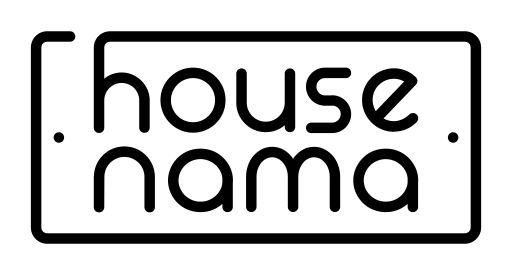Installation Guide
Nameplate Installation Guide
Every Housenama nameplate is delivered along with the accessories required to install the same. While we'd advise you to call a carpenter to complete the installation, here are the steps to be followed if you choose to do it yourself.
- Installation Guide for Nameplates with Spacers & Standoffs
- Installation Guide for Nameplates with Screws & Dome Caps
- Installation Guide for Nameplates with Keyhole Slots or Hooks
- Installation Guide for Nameplates with Welded Screws
Wallpaper Installation Guide
While our wallpapers are designed for a seamless finish, we strongly recommend professional installation for the best results. Experienced installers have the tools and expertise to ensure perfect alignment, bubble-free application, and a long-lasting finish. DIY installation is possible, but minor errors in measurement or pasting can affect the final look - so entrusting the process to an expert ensures your wallpaper looks exactly as intended.
Nameplates with Spacers & Standoffs

If your name plate has come with stainless steel spacers and stand-offs, here are the steps you need to follow:
- Once you have decided on the location, position the name-plate on the wall and make sure it's level. We recommend using a leveler.
- Since the nameplates come with pre-drilled holes for the standoffs to pass through, use it as a stencil and mark the position of the screw holes on the wall with a pencil.
- Pre-drill the wall with a pilot bit. You can choose to use a wall anchor (also called a wall plug) if you are unable to drill directly in to the surface.
- After the holes have been drilled, install each standoff base with a screwdriver or drill. Be careful not to over-tighten it (especially if you are using a power drill).
- Position your nameplate over the standoff bases, and tighten the standoff caps over the nameplate, sandwiching the nameplate between the standoff base and its cap. This step can simply be done by hand and does not need any equipment.
This step-by-step video can prove to be quite handy.
Nameplates with Screws & Dome Caps

If your nameplate has come with screws and dome caps, here are the steps you need to follow:
- Once you have decided on the location, position the nameplate on the wall and make sure it's level. We recommend using a leveler.
- Pre-drill the wall with a pilot bit right through the holes in the nameplate.
- After the holes have been drilled, you can fix the plate with the provided screws - either with a screwdriver or drill. You can then add the dome caps to the screw head.
Nameplates with Keyhole Slots or Hooks

If your nameplate has keyhole slots or some sort of hook at the back, you will need to drill screws in to the wall while keeping a portion of it's length exposed and available for hanging.
Nameplates with Welded Screws

- First step is to identify an area on the wall where the nameplate will be installed.
- Trace a rectangle (corresponding to the size of your nameplate) with a ruler and ensure the rectangle is level by viewing it from different distances.

- Now place your nameplate in the center of the rectangle and press it against the wall to mark the screw positions.
- Drill holes at the positions marked by the screws. Plastic wall plugs can be added in these holes and/or you could fill them with freshly prepared M-seal.
- Then insert the spacers in the screws at the back of the nameplate and hammer it in place into the drilled holes.
- You can also choose to fill the drilled holes with M-Seal prior to the previous step to achieve an extremely tight fit.
Wallpapers
1. Preparation
Measure & Plan
- Measure each wall’s height and width and calculate how many rolls you need (add ~10% extra for pattern matching and mistakes).
- Identify the pattern repeat on your wallpaper so you can align the design across strips.
Prep the Wall
- Clean the surface: Remove dust, grease, and old paint flakes.
- Repair imperfections: Fill holes, sand bumps; a smooth base avoids bubbles.
- If walls are freshly painted, let them cure at least 2–4 weeks.
- Apply a coat of wall liner or primer to reduce absorbency.
2. Tools You’ll Need
- Tape measure, spirit level / laser level
- Sharp snap-off blade or utility knife
- Pencil and ruler
- Wallpaper smoother or plastic squeegee
- Sponge and clean cloth
- Step ladder
- Wallpaper paste
- Paste brush or roller
3. Cutting & Aligning
- Cut panels with at least 5–10 cm (2–4 in) extra at top and bottom.
- Lay strips flat and check the pattern repeat so adjacent strips match seamlessly.
4. Hanging the Wallpaper
- Apply paste directly to the wall with a roller.
- Hang the dry wallpaper strip, starting at the top and smoothing downward.
- Overlap the top and bottom edges slightly, then trim with a sharp knife.
5. Finishing Touches
- Trim excess along ceiling and skirting boards with a sharp blade.
- Wipe off any paste with a damp sponge.
- Keep the room at normal temperature; avoid high humidity for 24 hours.
Pro Tips
- Start hanging from the centre or most visible corner so pattern alignment looks intentional.
- Change your knife blade often - dull blades tear paper.
- For textured or dark walls, use a lining paper or paint the wall in a similar colour to avoid show-through.
- If using large-scale patterns (like animal skin motifs you often design), check each strip before pasting to ensure the pattern flows correctly across seams.
